A villa inspired by floral Art Nouveau
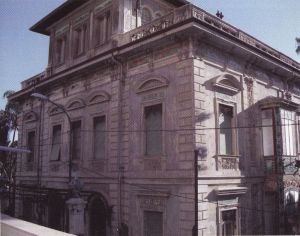 Situated in Via Fratelli Asquasciati just opposite the side entrance of the Casino, Villa Angerer, built on the site of a previous building dating back to 1880
Situated in Via Fratelli Asquasciati just opposite the side entrance of the Casino, Villa Angerer, built on the site of a previous building dating back to 1880 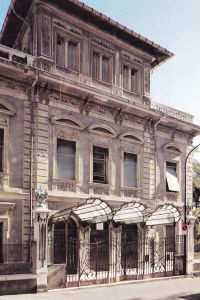 known as Villa Feraldi, was purchased at the end of the 19th century by the Austrian lawyer, bibliophile and botanist Leopold Angerer, originally from Innsbruck and endowed with a considerable patrimony, who intended to use the building as a winter residence.
known as Villa Feraldi, was purchased at the end of the 19th century by the Austrian lawyer, bibliophile and botanist Leopold Angerer, originally from Innsbruck and endowed with a considerable patrimony, who intended to use the building as a winter residence.
Angererer's express wish was to completely renovate the building from 1902 on a project by engineer Antonio Capponi, who availed himself of the valuable collaboration of Sanremo architect Francesco Sappia, who made his personal and innovative contribution to the renovation of the villa, applying the dictates of art nouveau in a creative and original way, evident above all in the ceramic floral inserts presumably derived from models attributable to Galileo Chini.
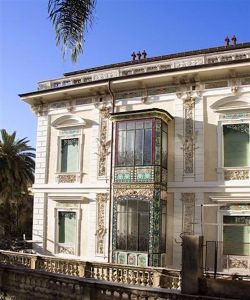 The interior and exterior decoration of the villa was instead entrusted to the Ticino decorator and stucco artist Luca Casella, who, together with his Piedmontese colleague Giovanni Bagliani, carried out the stucco work in the form of palms, floral and zoomorphic viluppings that follow the precious ceramic decorations on the outside, while on the inside they are elegantly flanked by the white and blue glazed terracotta overlays and the refined wall paintings, unfortunately in a poor state of conservation today.
The interior and exterior decoration of the villa was instead entrusted to the Ticino decorator and stucco artist Luca Casella, who, together with his Piedmontese colleague Giovanni Bagliani, carried out the stucco work in the form of palms, floral and zoomorphic viluppings that follow the precious ceramic decorations on the outside, while on the inside they are elegantly flanked by the white and blue glazed terracotta overlays and the refined wall paintings, unfortunately in a poor state of conservation today.
 According to the project prepared by engineer Capponi, the villa was therefore raised by one floor, which the owner, a passionate collector of books, used as a library, while the terraces of the building were closed by bay windows characterized by the typical and refined floral glass painted with irises; the finishing work on the exteriors was then completed by the rich stucco and polychrome majolica decorations partially carried out by the Saissi company of Menton and the wrought iron railings, among which the most successful is perhaps that of the internal staircase leading from the atrium to the upper floors of the villa.
According to the project prepared by engineer Capponi, the villa was therefore raised by one floor, which the owner, a passionate collector of books, used as a library, while the terraces of the building were closed by bay windows characterized by the typical and refined floral glass painted with irises; the finishing work on the exteriors was then completed by the rich stucco and polychrome majolica decorations partially carried out by the Saissi company of Menton and the wrought iron railings, among which the most successful is perhaps that of the internal staircase leading from the atrium to the upper floors of the villa.
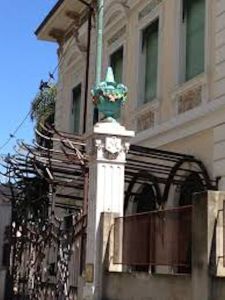 The square shape of the building, distinguished by the typical Jugendstil ornaments, is softened by the rich Art Nouveau decorations, omnipresent in every detail: from the bizarre terracotta chimneys with dragons and flowers on the roof, to the carved marble, stuccoes, glass and wrought iron, while the pillars at the entrance are finely embellished with elegant and refined turquoise vases.
The square shape of the building, distinguished by the typical Jugendstil ornaments, is softened by the rich Art Nouveau decorations, omnipresent in every detail: from the bizarre terracotta chimneys with dragons and flowers on the roof, to the carved marble, stuccoes, glass and wrought iron, while the pillars at the entrance are finely embellished with elegant and refined turquoise vases.
Those once present along the fence, characterized by whirling evolutions, have been partially lost because they were probably melted down for war reasons during the Second World War.
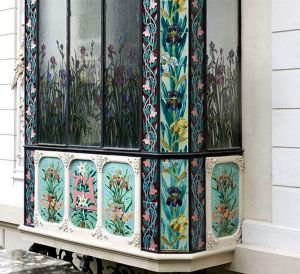
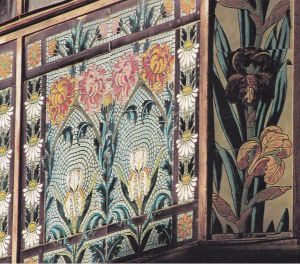 Finely worked are in particular the bay windows, decorated in the lower part with mosaics, decorated tiles and zoomorphic wrought iron, while in the central mosaic of one of these balconies the initials "LA", interlaced, by Leopold Angerer have been impressed.
Finely worked are in particular the bay windows, decorated in the lower part with mosaics, decorated tiles and zoomorphic wrought iron, while in the central mosaic of one of these balconies the initials "LA", interlaced, by Leopold Angerer have been impressed.
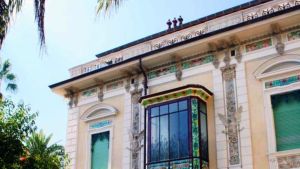 Equally richly decorated is the interior of the villa, where all the doors were carved and all the glass was ground crystal. The ceilings are also frescoed, the walls adorned with worked wood, the polychrome stained-glass windows threaded in lead.
Equally richly decorated is the interior of the villa, where all the doors were carved and all the glass was ground crystal. The ceilings are also frescoed, the walls adorned with worked wood, the polychrome stained-glass windows threaded in lead.
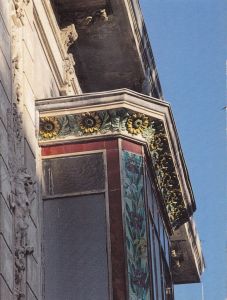 From the north side one enters a spacious atrium, which occupies the central part of the villa for the height of two floors, from which one enters a large hall and the reception rooms.
From the north side one enters a spacious atrium, which occupies the central part of the villa for the height of two floors, from which one enters a large hall and the reception rooms.
From the atrium, whose walls are adorned with precious tapestries, a large staircase in marble, carved wood and wrought iron goes up to the second floor, while, on the left of the staircase, a door surmounted by stuccoes and a white ceramic lunette with a blue background, allows access to the staircase that descends to the salle à manger and the adjacent rooms, located at garden level, and can also be reached from a large terrace with external staircase located in front of the reception rooms.
The dining room, finished in wood, stands out in particular for its typical doors with polychrome lead-threaded stained-glass windows that have many similarities with those present in the old Kaffeehaus of the Austro-Hungarian Empire. From the second floor you can access the bedroom area, from which it is possible to overlook the atrium through a small balcony located in front of the entrance, decorated with many wrought iron and floral elements with the "A" in the centre, the initial, present almost everywhere, of the owner of the building.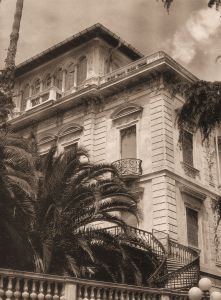 On the third and last floor there was the Angerer library, on which there were two spacious side terraces, as well as a smaller one located on the south side towards the sea.
On the third and last floor there was the Angerer library, on which there were two spacious side terraces, as well as a smaller one located on the south side towards the sea.
During 1909 further embellishment and renovation works were carried out on the building, in which all the peculiar features of the art nouveau present in those years in Sanremo can be found. Particularly effective and incisive was the fusion between the mass-produced decorations and the refined artefacts made by skilled craftsmen and stucco workers, such as the already mentioned Casella and Bagliani, while the interiors were frescoed with delicate floral and zoomorphic motifs, according to a typically Art Nouveau taste, by Giorgio Ceragioli, belonging to a group of painters who came to the City of Flowers following the Piedmontese architect Pio Soli and the already mentioned Luca Casella.
Ceragioli also collaborated with the painter and decorator Giovanni Battista Carlo, who created a series of valuable frescoes and paintings inside the villa.
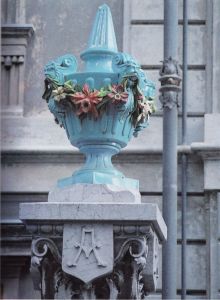 Among the most artistically successful exterior artefacts is the large flowered ceramic vase, which represents a standard product above the carved marble base, made according to the most genuine forms of the Arts and Crafts movement. The three-storey tower located in the south-west corner of the garden was instead built with bricks from the different countries of the world visited by Angerer.
Among the most artistically successful exterior artefacts is the large flowered ceramic vase, which represents a standard product above the carved marble base, made according to the most genuine forms of the Arts and Crafts movement. The three-storey tower located in the south-west corner of the garden was instead built with bricks from the different countries of the world visited by Angerer.
Also of note is a cave with rocks, statues and water features and, at the north-western end of the park, the evocative Grotta del Drago, with the gentle dragon carved on a wall. Once there was also a statue of a deity, now disappeared, in homage to the vaguely oriental fashion of the time.
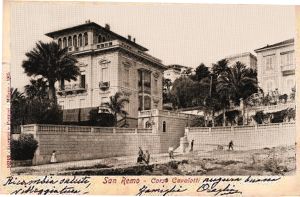 The villa continued to be inhabited uninterruptedly by Angerer until 1937, when, after being informed of the project for the erection of a five-storey building next to the Casino, between his home and the sea, by the builder Ferrero, the Austrian lawyer, who had no intention of giving up the view of the sea, decided to immediately put the building up for sale at the price of one million lire.
The villa continued to be inhabited uninterruptedly by Angerer until 1937, when, after being informed of the project for the erection of a five-storey building next to the Casino, between his home and the sea, by the builder Ferrero, the Austrian lawyer, who had no intention of giving up the view of the sea, decided to immediately put the building up for sale at the price of one million lire.
The managers of the Casino, who at the time were Mr. and Mrs. Belloni, proposed a considerable discount and in the end they made the purchase for six hundred thousand lire. The administrators of the Casino Matuzian were also hoping for an appeal that could have the building permit revoked, given the proximity that would have damaged the Casino.
The lawsuit, however, despite having been entrusted to a lawyer such as the famous lawyer Cassinelli of Rome, was lost by the Belloni family, so that Palazzo Ferrero was built and Villa Angerer was used much later as the Casino's offices and representative rooms.
In the meantime Angerer, who had moved to a house in the San Martino district, after remaining alone in 1940 following the death of Maria Angerer, who is now resting in the Cemetery of the Mouth, returned to Austria and left no more news of himself.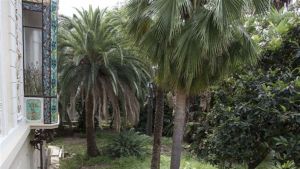 In 1991 the villa was purchased by the Municipality of Sanremo to provide the Casino with offices in a particularly prestigious location, a library on gambling and a museum of the Italian Song Festival.
In 1991 the villa was purchased by the Municipality of Sanremo to provide the Casino with offices in a particularly prestigious location, a library on gambling and a museum of the Italian Song Festival.
Since then the historic building has been practically abandoned, while the increasingly massive infiltrations of water progressively contribute to undermine even the very stability of the villa, whose undisputed artistic value should lead to the launch of a project for the recovery and renovation of the building.
The Municipality has recently carried out a renovation which, for one reason or another, has not been completed. The park was in fact reopened for the views but was immediately closed for personnel problems.
(sources: Text by Andrea Gandolfo; images from private archive)




